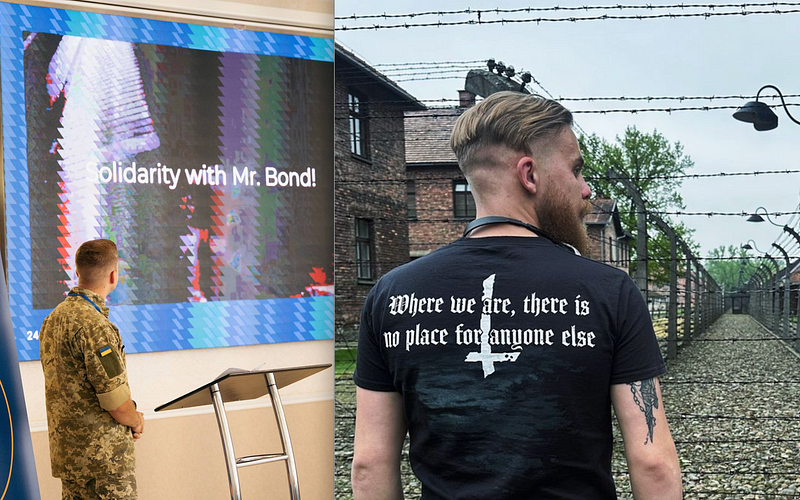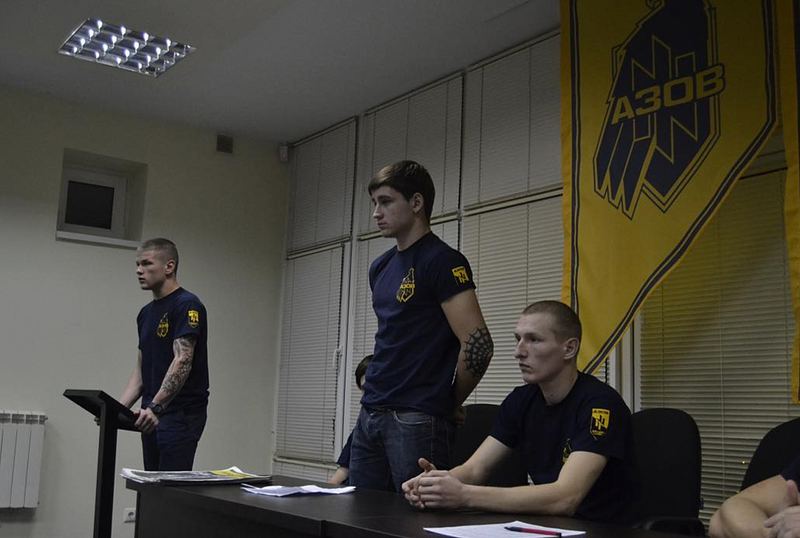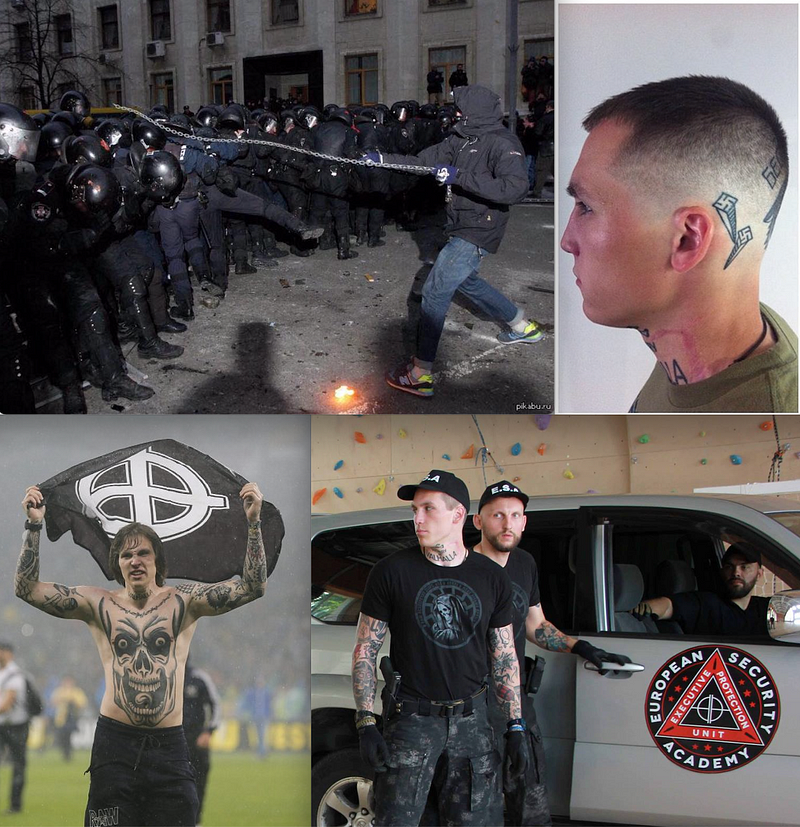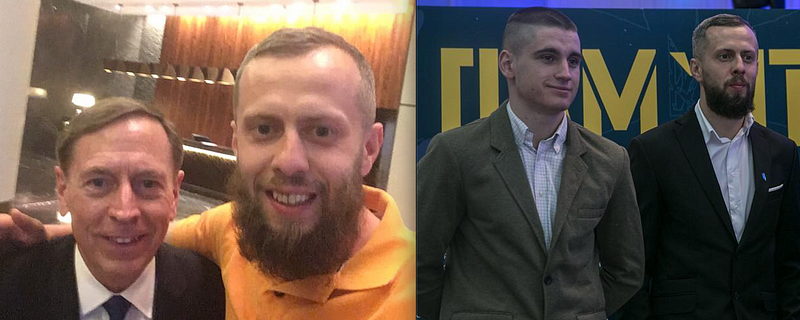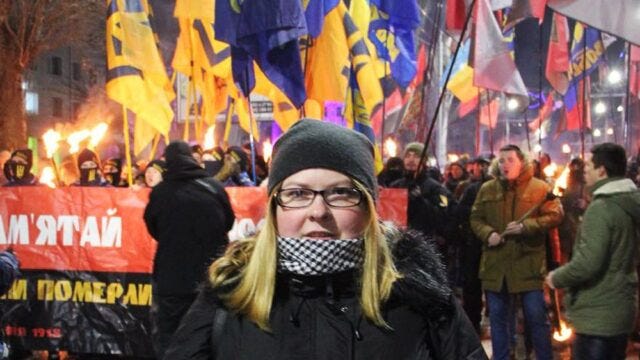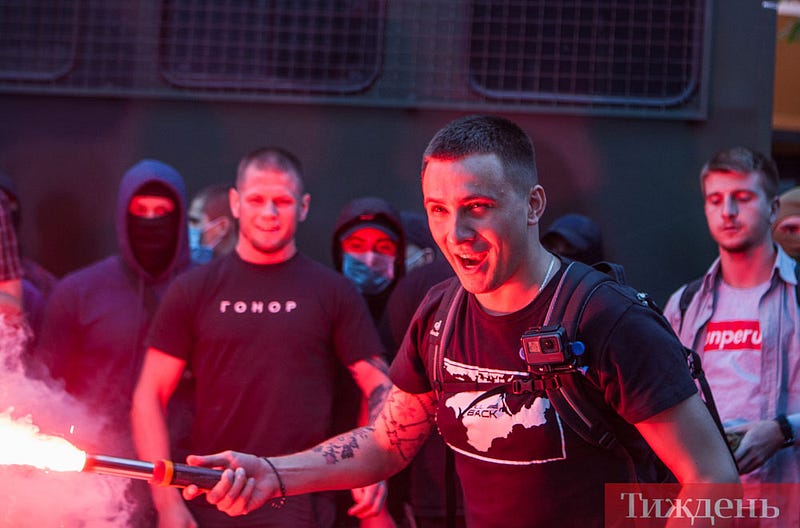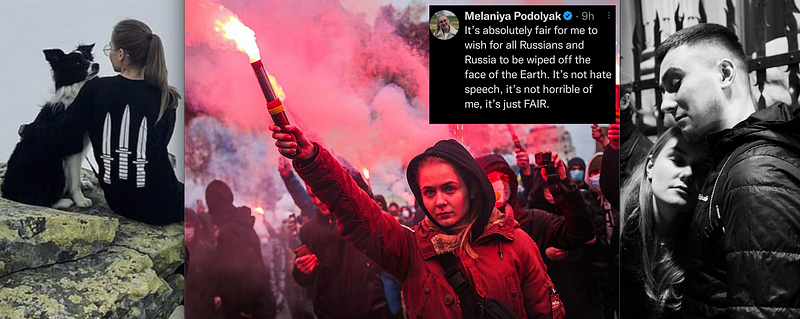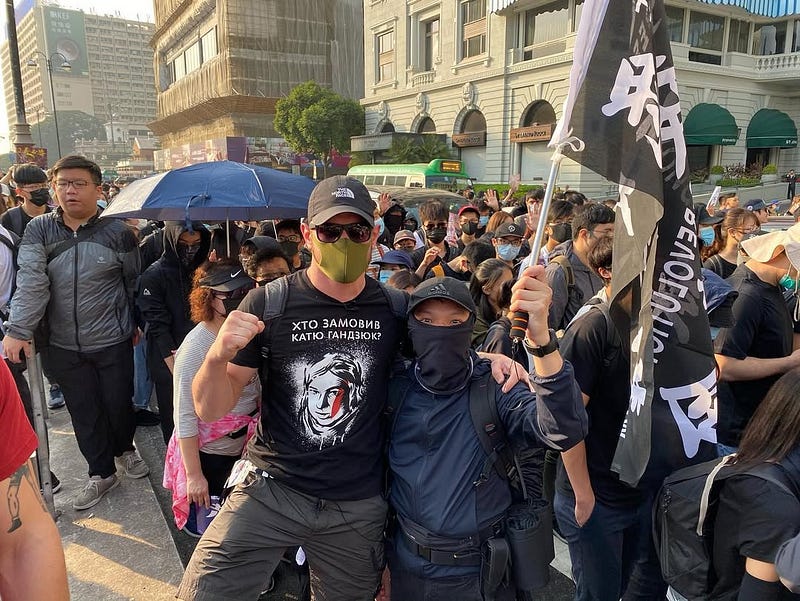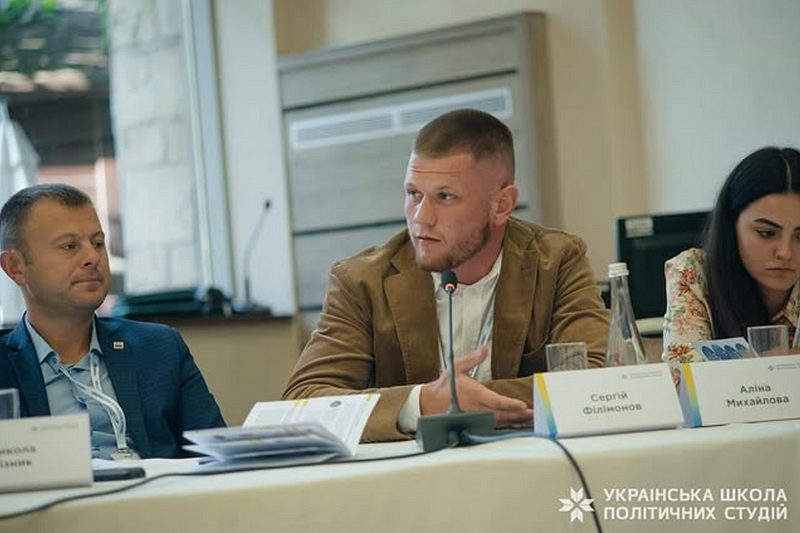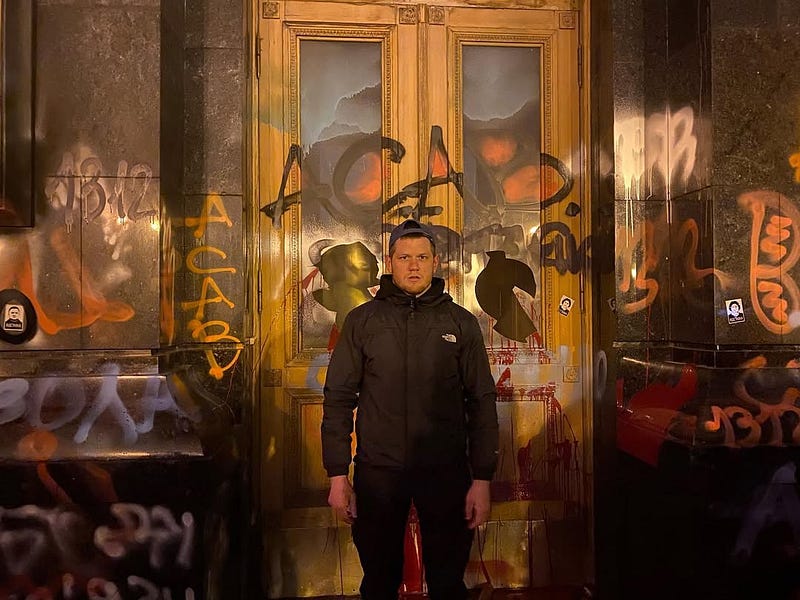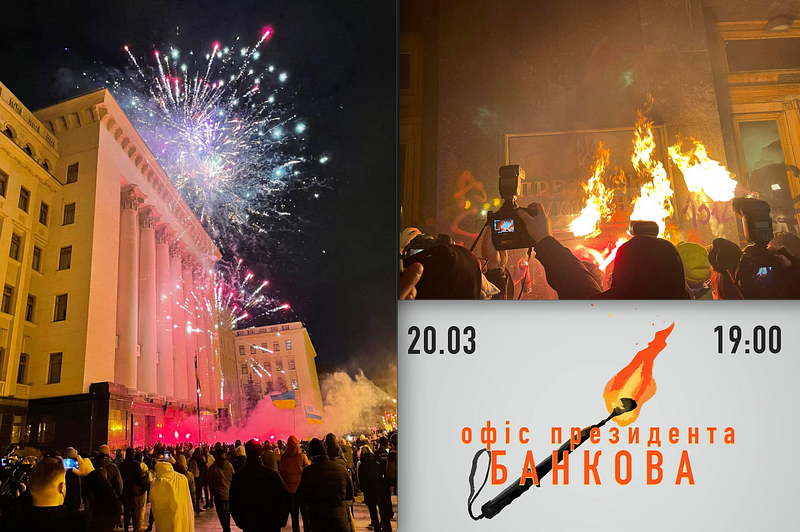It is no small task and I know that readers of my blog will be sensitive as to how enormous this undertaking is. Because of Yad Vashem's determination to ensure that Holocaust history fits their preconceived ideological framing, Yad Vashem has had to reject a number of books that they might have published which any holocaust institute worthy of the name would have grasped with 2 hands.
The first such was Raul Hilberg's The Destruction of the European Jews. First published in 1961 and updated since it remains the most comprehensive history of the holocaust. Even Yad Vashem's academic advisor, Professor Yehuda Bauer was forced to admit it is 'unsurpassed'. It is not for nothing that Yad Vashem is incapable of producing a general and comprehensive history of the Holocaust.
Hilberg, who became the Professor of Holocaust History at Vermont University, saw the Judenrate as an instrument of the Nazis who were essential to the implementation of the Final Solution. Yad Vashem didn't appreciate such an analysis since two-thirds of the Judenrate were Zionists!
Polish [neo]fascist Michal Kaminski who justified the murder of Polish Jews in Jedwabne visits Yad VashemLikewise Yad Vashem didn't appreciate Hilberg's dismissal of Jewish Resistance during the Holocaust as minor as Zionist history consciously magnifies it and on occasion invents it in order to provide itself with a retrospective justification and back story.
When it came to the escape of Rudolf Vrba and Alfred Wetzler from Auschwitz in April 1944 Yad Vashem decided that the best thing to do was to ignore them. Not only were they not Zionists but they came into conflict with Zionist collaborator, Rudolf Kasztner who, in the words of Israeli Judge Benjamin Halevi in 1955, 'sold his soul to Satan' when he agreed a deal with Eichmann for a train out of Hungary for 1684 of the Zionist/Jewish elite in return for silence about where the deportation trains were heading.
Kasztner, who was the plaintiff in a libel trial in Israel in 1954 when accused of collaboration, rapidly turned into the de-facto defendant. When Israel's second government led by Moshe Sharrett decided to appeal the verdict of the first trial, that Kasztner was a collaborator, it promptly fell. Kasztner has nonetheless been rehabilitated by Yad Vashem.
No matter that Kasztner’s deal with Eichmann led to the truth of Auschwitz being kept from Hungary’s 700,000 Jews resulting in nearly ⅔ of them being deported to their deaths. This is a minor matter. What is important is that his deal with Eichmann saved 1600 Zionist and Jewish leaders. The fact that he went to Nuremberg after the war to provide testimony for major [Axis] war criminals is erased from history.
Suffice to say YV wouldn't publish Vrba's memoirs 'I cannot forgive'. In fact they were determined to erase Vrba and Wetzler's very names from Yad Vashem. It is with difficulty that one could find any mention of them until, the late 1990's when Ruth Linn, Professor of Education at Haifa University, began a campaign in their favour. At one point Yehuda Bauer called Linn an 'anti-Zionist'. There is no worse insult in the Zionist dictionary than that!!
Suffice to say Yad Vashem weren't interested in the history of the Warsaw Ghetto Revolt by its last Commander, Marek Edelman. Edelman's misfortune was being a member of the anti-Zionist Bund and a supporter of the Palestinian resistance.
In the words of Daniel Blatman, an Israeli holocaust scholar, Yad Vashem is a 'diplomatic laundromat for every fascist and anti-Semite who darkens its doors.' And there have been a lot of them – Trump, Brazil’s Bolsonaro, the Philipenes Duterte and assorted neo[fascists] from Germany and Austria.
In 1976 South Africa’s Prime Minister, John Vorster, who had been interned during the war because he was a member of the neo[fascist] Afrikaner Broederbond and Ossewa Brandwag, visited Israel as a guest of the Israeli Labor Party government. Naturally he was taken on a tour of Yad Vashem.
Israel Shahak, a survivor of the Warsaw Ghetto and Bergen-Belsen wrote
Of the Yad Vashem… theatre, I do not wish to speak, at all. It, and its vile exploiting, such as honouring South Africa collaborators with the Nazis, are truly beneath contempt.
Capitalism in Decay
Fascism is capitalism in decay. As with anticommunism in general, the ruling class has oversimplified this phenomenon to the point of absurdity and teaches but a small fraction of its history. This is the spot for getting a serious understanding of it (from a more proletarian perspective) and collecting the facts that contemporary anticommunists are unlikely to discuss.
Posts should be relevant to either fascism or neofascism, otherwise they belong in !latestagecapitalism@lemmygrad.ml. If you are unsure if the subject matter is related to either, share it there instead. Off‐topic posts shall be removed.
No capitalist apologia or other anticommunism. No bigotry, including racism, misogyny, ableism, heterosexism, or xenophobia. Be respectful. This is a safe space where all comrades should feel welcome.
For our purposes, we consider early Shōwa Japan to be capitalism in decay.
In recent months, a remarkable development in the Empire’s decline has gone almost entirely unnoticed. The National Endowment for Democracy’s grant database has been removed from the web.
Of course, despite NED brazenly purging evidence of its vast operations from the web, that conniving continues apace regardless, covertly. One might even argue the Endowment’s chicanery is all the more dangerous now, given individuals and organizations can conceal their funding sources. But the move amply shows NED today cannot withstand the slightest public scrutiny, which its existence was intended to exemplify. It also demonstrates that “overt operations” with open US funding are now the very “kiss of death” the Endowment was meant to replace. The Empire is on the run.
The impending availability of the material has been controversial in the Netherlands because relatively few of the people in the database were ever formally charged with crimes. Not all even faced formal investigations.
The Dutch government investigated 300,000 people for collaborating with the [Axis] and more than 65,000 of them stood trial in a special court system in the years after World War II.
Collaboration enabled the [Axis] to murder an estimated three quarters of Dutch Jews, including their most famous victim, Anne Frank, and her family. The identity of the person who exposed Frank’s hiding place has been a matter of debate.
It was not until 2020 that the Dutch government apologized for failing to protect Jews during the Holocaust, long after other European leaders and after local Jews had requested an apology.
More recently, some institutions in the Netherlands have sought to make amends for their rôle in the Holocaust locally. The Dutch public tram company GVB, for example, sought compensation after the war for having transported Jews to their deaths; earlier this year, it announced that it would place memorials at three deportation hubs, and the city of Amsterdam pledged 100,000 euros — and potentially more in the future — to local Jewish groups to divest itself of its revenue from collaborating with the [Axis].
With all of the numerous literature on the Shoah, it is surprisingly difficult to find (English) works focussing on the Fascist assault on Jewish cultures; most barely touch on the subject. Many sources (such as this one) are content to simply remind us of the Shoah’s death toll as if that automatically does all of the explaining for them, but the Western Axis’s incomplete annihilation of Yiddishists only tells us half of the story.
As I’ll soon show you, the Fascist approach to Jewish cultures was actually less straightforward than you might expect, but there was certainly an element of annihilation involved:
In Poland, in both Bedzin and Poznan, special German “Brenn-Kommandos” (arson squads) were assigned to burn the Jewish synagogues and books.¹¹ The destruction of Torah scrolls and other religious books was especially difficult for the religious Jewish community, since according to orthodox religious law, it is imperative that these materials be treated with the utmost respect and reverence, and those who destroy such sacred documents are considered in violation of a divine command. It is stated: “The sefer torah, or any sacred book or writing, or anything which has served a holy purpose, which has become worn out, must not be burned but secreted.”¹²
Some Jews attempted to save Torah scrolls and other materials from the burning buildings but were either shot or thrown into the flames.¹³ In such a way the Great Talmudic Library of the Jewish Theological Seminary in Lublin burned while [Fascists] cheered and Jews wept.¹⁴ [Fascist] correspondents stated:
For us it was a matter of special pride to destroy the Talmudic Academy […] which was known as the greatest in Poland […] We threw the huge Talmudic library out of the building and carried the books to the market-place, where we set fire to them. The fire lasted twenty hours. The Lublin Jews assembled around and wept bitterly, almost silencing us with their cries. We summoned the military band, and with joyful shouts the soldiers drowned out the sounds of the Jewish cries.¹⁵
[…]
In the Vilna ghetto […] the books read there were in Polish (70.4 percent) and Yiddish (17.6 percent), with Russian, Hebrew, and other languages making up the rest. Within four months circulation increased to about 140,000 and the library was “full of readers.” However, by September of 1943 the ghetto was liquidated and along with it much of the material from the ghetto library, which was used by the janitor to heat the furnace of the house.⁵⁶
Nonetheless, the incendiary method, as far as I can tell, was exceptional rather than standard. The Axis had more ‘refined’ ways of dealing with Jewish literature:
Dr. Pohl arrived in Vilna in January 1942 together with four assistants (two of whom had academic training), Drs. Miller, Wulf, Sparkett, and Gimpel. He ordered that all the Jewish book collections should be gathered at the Yiddisher Visenshaftlikker Institut (YIVO) building at 18 Wiwulski Street.
Books soon began to arrive and included materials from more than 300 synagogues as well as private collections. In addition to books, Pohl also disposed of the plates of the Romm publishing house, noted for its editions of the Talmud.⁴⁰ The remains of the Kletzkin publishing house were also brought to YIVO but were sent mainly for pulping.⁴¹
The Jewish Council (Judenrat) in Vilna was ordered to provide twenty workers, five of them experts in Judaica, to select, catalog, and ship the books. One hundred thousand volumes were arranged by century of publication; 20,000 of these in seventy-four cases were then shipped to [the Third Reich] with the rest being sold to a paper mill for pulp at nineteen Reichsmark per ton.⁴² Pulping was a widespread practice and initially there were few guidelines to determine what should be saved.
Now this is when things become complicated. Long-term readers are surely familiar with how the Fascists destroyed synagogues (e.g. Rashi Shul), yet you might have never particularly noticed the inconsistency where they sometimes let others (e.g. Altneuschul) simply gather dust. A similar inconsistency towards Jewish literature existed:
However, in February 1943, Dr. Cruse of the ERR issued the following directive: “Books in Hebrew script of recent date (later than 1800, insofar as this can be determined) may be turned over for pulping; this applies to prayerbooks, Memorbuecher and other religious works in the German language. On the other hand, please send here all writings which bear on the history of culture and the nature of Judaism, as well as the works of Jewish authors.”⁴³
From my research, it looks like most Third Reich officials preferred to stop, but not exactly annihilate, Jewish cultures. What I mean by this is that in many cases they were content to merely seize Yiddish and other Jewish works as trophies, not always with an intent to destroy them, but without expecting a future for Yiddish either:
In December 1939 [Berlin] decreed that all book collections in Poland, other than those owned by German natives, were to be confiscated and so ordered them to be surrendered.¹⁷ In Warsaw the great library of the Synagogue and of the Institute of Jewish Studies, with its collections related to the Near East and rare manuscripts from the tenth century, was taken away to Berlin by a special unit led by Professor Paulsen. Other Jewish libraries from Warsaw were sent to Vienna.¹⁸ Jewish libraries from Łódź and other areas were relocated to St. Michael's Church in Poznan, which was unused because of the transfer of the entire Polish population.¹⁹
In 1941 the [Axis] founded a Reichsuniversität in Poznan with a professorship for Jewish history and languages and a library of about 400,000 volumes in Judaica confiscated from Jewish libraries. Jewish books were also transferred to other [Fascist] institutes in Poland, including the Institut für deutsche Ostarbeit in Cracow, founded in 1940 as a research division on East European Jewry and a branch of the Institut zur Erforschung der Judenfrage of Frankfurt in Łódź.²⁰
It is possible that books from Poland and other areas of the East were sent to other large libraries of the Reich but there is no definitive evidence of this. There is, however, a letter from the Prussian State Library in 1943 expressing an interest in approximately 30,000 materials that had been collected in Vilna. Other materials found their way informally to institutions and individuals.²¹
A few Jewish adults noticed the paradox of the Axis preserving certain Jewish works. Quoting Elisabeth Gallas's A Mortuary of Books: The Rescue of Jewish Culture after the Holocaust, page 59:
The survival of a collection was rarely coincidental or arbitrary: The [Fascists] themselves had determined whether it was destroyed or confiscated. Joshua Starr, chief executive of the JCR in New York who worked at the Offenbach Depot from June 1948 to April 1949 on behalf of his organization, described this phenomenon: “Today when one handles a book stamped Sichergestellt durch Einsatzstab RR, he holds a mute witness of the final phase of a program designed to concentrate staggering facilities for the investigation of the Jewish past and present. […] It is, as we shall see, largely to this bizarre program that we owe credit in the grim sense, for the survival of portions of Jewish property in central Europe.”¹³⁴
Hannah Arendt later refers to the same paradox in her famous report Eichmann in Jerusalem, in which she describes the German authorities' painstaking approach to the looting and amassing of Jewish cultural property: “Incidentally, an eagerness to establish museums commemorating their enemies was very characteristic of the Nazis. During the war, several services competed bitterly for the honor of establishing anti-Jewish museums and libraries. We owe to this strange craze the salvage of many great cultural treasures of European Jewry.”¹³⁵
Lastly, there is a certain Herzlian fascist whom I would like to cynically thank for inspiring me to research this subject. Quoting Dan Tamir’s Hebrew Fascism in Palestine, 1922–1942, pages 146–147:
Having read that members of a Yiddish speaking socialist group had sent to their colleagues in Vilnius some of the stones which were thrown on them, together with their blood-stained shirts, Aḥime’ir joyfully promised them that
if they continue to spread here their Ashdodian language, then the empty museum of “Culture for the Wearies” in Vilnius will soon be filled with shirts and stones from our country. And if they continue importing Yiddish to our country, then they will also find themselves exporting more shirts, stones, shards of glass and broken skulls…¹⁷
(Emphasis added in all cases.)
Further reading: Stolen Words: The Nazi Plunder of Jewish Books & Occupied Words: What the Holocaust Did to Yiddish.
Earlier in 2024, Azov’s openly neo-Nazi brigade in the Ground Forces of Ukraine announced that a handful of its fighters were launching a summer tour of Europe. Apparently they were expecting to be treated like rock stars. This unit, the 3rd Assault Brigade, is not to be confused with Azov’s other (more famous) brigade in the National Guard, which has made an effort to refine its image for Western liberals.
Much of the tour was cancelled, a month before the “Nation Europa” event, and not long after yours truly revealed that a decorated 3rd Assault fighter visited Auschwitz to mock the Holocaust. He went there wearing a shirt from the Russian-Ukrainian neo-Nazi band “M8L8TH” with a quote attributed to Hitler on the back. Thanks to Dreznica Goat, readers of this blog already learned that the bass guitar player in M8L8TH is a medic in the 3rd Assault Brigade who represented the Nation Europa network at a roundtable of neo-Nazis on Ukraine’s Independence Day.
On the left, from the “Nation Europa” conference, a slide says “Solidarity with Mr. Bond!” referring to an Austrian neo-Nazi sentenced to 10 years in prison. On the right, a picture from the Auschwitz stunt.My article about the conference failed to identify several of the participants, most importantly Andriy Malkov, an organizer of the event, who made multiple speeches and moderated the roundtable discussion. He also appears to have served in the 3rd Assault Brigade, which is commanded by Azov leader Andriy Biletsky.
Malkov was once part of the “Rodychi” (Relatives) gang of white supremacist football hooligans in Kyiv, from which an important clique in the Azov movement — and a rival splinter group — emerged. For more than half a decade, his old friend Serhii Filimonov has led the militant organization “Gonor” (Honor), which essentially “sold out” as the [neofascist] [neo]pagan stormtroopers of the Western-funded NGO complex in Ukraine. Apparently they are no longer friends. It’s easy to imagine that the future organizer of “Nation Europa” found himself at a crossroads.
“Nation Europa” organizer Andriy Malkov, seen above-right with Ulana Suprun, former Healthcare Minister of Ukraine (2016–19)A coalition of neo-Nazi hipster hooligans, radical NGO activists, far-right influencers and military fundraisers is apparently being groomed for the big stage by powerful interests, if only to ride the coattails of a potential successor to Volodymyr Zelensky.
Serhii Filimonov, in his younger days on the right. On the left, his tattoos include a Nazi Totenkopf above his knee, neo-pagan symbols on his shoulders, and between them it says, “Victory or Valhalla.”Over ten years ago, Andriy Malkov commented on a picture of Serhii Filimonov, 19, wearing the same shirt from the “White Boys Club” that we’ve already seen on Malkov. The White Boys Club is an umbrella of hooligan firms that support FC Dynamo Kyiv and the Azov movement. In 2014, Filimonov joined the Azov Battalion with the call-sign “Son of Perun,” referring to the Slavic god of war that neo-Nazi [neo]pagans tend to worship. In a 2022 interview, Filimonov said, “those who are interested know that ‘Gonor’ are pagans. And many [far-right/neo-Nazi] symbols that can scare people are actually related to our religion.” In fact, “We look after the temple on Lysa Hora.”
Serhii Filimonov and friends from Gonor at the Perun shrine on Lysa Hora (Bald Hill) in Kyiv. “Son of Perun” apparently edited the picture on the right to remove Sashko Vovk’s openly neo[fascist] tattoos.Malkov and Filimonov fought in the Azov Battalion a decade ago, when it had a reputation for being an openly neo[fascist] unit. Subsequently, they joined the nascent Azov movement’s Civic Corps, a forerunner to its political party, the National Corps. “Son of Perun” led the Kyiv branch of both organizations. The journalist Oleksiy Kuzmenko tells us, “Filimonov’s old social media posts from his days in the Azov include a 2014 post seemingly honoring Adolf Hitler’s birthday with thematic songs and a commentary ‘I regret that you won’t rise up like Jesus, grandpa’, etc. Filimonov’s VK also links to ‘SoberNazi’ Twitter handle.”
Left to right at a 2015 meeting of the Azov Civic Corps: Serhii Filimonov, Andriy Malkov, “Sashko Vovk”After Dynamo Kyiv won the 2015 Ukrainian Cup final, fans swarmed the field and Malkov’s friend Rostislav Karpich ran onto the pitch with a swastika on his shirt. Malkov had the same one. Later that year, Rodychi hooligans from the Civic Corps — including Filimonov’s close friend Ihor Potashenkov, or “Malyar” (Painter) — viciously attacked black soccer fans at a European Champions League match in the Ukrainian capital.
Clockwise from top-right: Ihor Potashenkov attacking a black soccer fan (2015), Potashenkov and Malkov at a Dynamo Kyiv game (2017), Rostislav Karpich and Malkov in Vienna (2018), and Karpich with his swastika shirt (2015)Filimonov’s gang of [neofascist] hooligans went unpunished for these high-profile hate crimes, despite an international media spotlight and consequences for Dynamo Kyiv. Oleksiy Kuzmenko noted in 2018, Potashenkov was an “active participant of some of Ukraine’s iconic and more controversial moments during the [2013–14] Euromaidan demonstrations.” Kuzmenko reported that in 2016, this notoriously violent neo[fascist] with “clearly visible swastika tattoos” on his head nevertheless received “sophisticated training” from the European Security Academy based in Poland.
Evolution of Ihor Potashenkov, aka “Malyar” — from attacking riot police in Kyiv (2013) to wearing a neo[fascist] shirt while undergoing his training at the European Security Academy in Poland (2016)From 2015–18, Andriy Malkov appears to have grown as close as ever with Filimonov’s circle of Azov veterans, in particular Ihor Potashenkov and Nazarii Kravchenko, who was the deputy head of the National Corps. In 2018, the State Department’s annual report on human rights practices in Ukraine described the National Corps as a “nationalist hate group.” That year there was a series of neo-Nazi attacks on Romani people and settlements in Ukraine. Filimonov led a group of Azov militants that perpetrated at least one of these “pogroms.”
In the coming weeks, Kateryna Handziuk, an “anti-corruption activist” in Kherson, was attacked with sulfuric acid. Later that year, Handziuk died of complications from the severe injuries that she suffered, and Filimonov’s crew supported the protest campaign, “Who Killed Katya Handziuk?” This appears to have forged an alliance between the Rodychi hooligans and leaders of Ukrainian civil society™ which probably encouraged Filimonov to spearhead an Azov splinter group in 2019. As a project manager for the Ukrainian Helsinki Human Rights Union once said,
I had a very cautious optimism when some of the not-so-recent people from the National Corps moved away from Biletsky, created their own civilized NGO, and began to cooperate with healthy civil society forces. In fact, Nazarii Kravchenko, Serhii Filimonov, Igor Malyar [Potashenkov] and all of Gonor became the “security service” during peaceful actions, in which everyone participated: right-wing, left-wing, human rights defenders, veterans… And it was a process of unification that made me very happy.
Nazarii Kravchenko, neo[fascist] former leader of the National Corps (Azov political party), with former CIA director David Petraeus (left, 2019) and Andriy Malkov (right, 2017)Perhaps the “best man” in this marriage, Serhiy Sternenko is a nationalist influencer in Ukraine, and former leader of the extremist Right Sector in Odessa who rebranded as a radical anti-corruption activist. Under Sternenko’s local leadership, Right Sector helped to perpetrate the May 2014 massacre of anti-Maidan activists in Odessa. His friend Kateryna Handziuk was among those who praised the far-right “patriots” that instituted “Ukrainian order” in this Russian-speaking city of southern Ukraine (and poured gasoline on the fire in eastern Ukraine).
Kateryna Handziuk at a nationalist marchSerhii Filimonov’s dramatic falling out with Azov leader Andriy Biletsky was related to his budding alliance with Serhii Sternenko. Biletsky and other Azovites reportedly beat up Filimonov and his right-hand man Nazarii Kravchenko in 2020, and “demanded to know who ordered the media support for Sternenko.”
Two months before Handziuk was viciously attacked with acid outside her home in Kherson, another man assaulted Sternenko in Odessa and wound up dead. To hear it from Christopher Miller, now the Financial Times correspondent in Ukraine, “Sternenko chased the attacker down and sliced his gut open, spilling out his intestines. He posted a video of it and has boasted about chasing the guy down after he was attacked.”
Sternenko subsequently acquired hero status among Rodychi hooligans and radicalized NGO liberals. According to the sociologist Volodymyr Ishchenko, “Sternenko is an especially notorious case of a criminal who found a way to avoid punishment for many years via switching from far-right to a pro-Western liberal. I don’t understand why he should be allowed to do this. The civil society that applauded this is very sick.” Katherine Quinn-Judge, a former senior analyst at the International Crisis Group, explained in 2021, “A critical mass of young Ukrainian liberals consider Sternenko A-OK, because a) he’s anti-Russian, b) he’s said that beating up gays isn’t compulsory, c) he has opposed genuine corruption in Odesa, and d) he’s started wearing glasses and whatnot.”
Serhii Sternenko (and Filimonov on the left)The campaign to “Free Sternenko” gave these nationalist bedfellows another cause to rally around (typically with flares, supplied by the Nazi protest experts), which culminated in a riot outside of the presidential office building on his 26th birthday. In the meantime, Sternenko’s friends from the NGO complex grew closer to Gonor. A perfect example is Melanie Podolyak, the daughter of a former deputy minister of culture.
Melanie Podolyak, with Sternenko on the right, wearing a Gonor shirt on the leftSternenko and Podolyak were apparently both friends of Kateryna Handziuk, and by 2021 some people speculated that they were dating. From roughly 2016–19, Podolyak worked as a project manager for the Lviv Media Forum and later the Lviv Security Forum, in which capacity she repeatedly brushed shoulders with retired US general Ben Hodges, a major cheerleader of proxy warfare in Ukraine.
By 2019, Podolyak became an assistant to Oksana Syroyid, a leader of the “Samopomich” (Self Reliance) party and deputy chair of the Ukrainian parliament. Melanie Podolyak reportedly also advised the international department of this pro-Western political party, which was wiped out in the 2019 parliamentary elections. “Low polling doesn’t stop Self Reliance from being every allied embassy’s reform favorites,” observed Jonathan Brunson, a “political warfare analyst” with an eye on the far-right in Ukraine.
Later that year, Podolyak probably took part in Gonor’s new “Academy of Street Protest” featuring Sternenko, Filimonov, and Potashenkov. In any case, she started to wear a shirt from the Gonor “Academy,” the symbol of which is a Molotov cocktail. “Son of Perun” and “Malyar” then visited Hong Kong in December 2019 to engage in “protest tourism.” Filimonov shared a picture of himself at a demonstration wearing his “Who Killed Katya Handziuk” shirt. He captioned his Instagram post in English: “Fight for Freedom!! Stand with Hong Kong!!”
Filimonov in Hong Kong. “What the Hell Are Ukrainian Fascists Doing in the Hong Kong Protests?” asked Vice News. “Far-right hooligans from Ukraine at the Hong Kong protests,” reported the Atlantic Council’s Digital Forensic Research Lab. Apparently these outlets did not yet receive the memo about Gonor’s “evolution.”In 2019, the Ukrainian School of Political Studies (USPS) created an annual scholarship to honor the memory of its 2015 graduate Kateryna Handziuk. Due to the COVID-19 pandemic, “Son of Perun” had to wait until 2021 to become the second recipient of the Handziuk scholarship. According to the USPS, “Filimonov’s activity matches Ukrainian School of Political Studies values. By his work, Serhiy, like Katya Handziuk, defends the interests of the democratic state of Ukraine.” The Council of Europe, “the continent’s leading human rights organization” — not to be confused with the EU’s European Council — funds the USPS, which is proud to be associated with several people in Filimonov’s orbit.
Filimonov at a session of the Ukrainian School of Political StudiesThe USPS awarded Filimonov the scholarship in July 2021, evidently for a summer program. Earlier that year, Filimonov was detained for “hooliganism,” and placed under house arrest, after a mob of Sternenko supporters assaulted the presidential administration building, to protest a prison sentence of seven years for their hero’s kidnapping of a local politician in 2015. Later that year, a court commuted this sentence, and according to Sternenko, the president even offered to make him the head of the Odessa department of the Security Service of Ukraine.
Filimonov after Sternenko supporters attacked the presidential office building. [The 'C' in 'ACAB' there does not necessarily refer to either cops or capitalists.]“Happy birthday Serhii Sternenko,” Melanie Podolyak captioned a Facebook post with her pictures from the incident. The day before Sternenko supporters smashed the front doors, heavily graffitied the facade, and burned the entrance sign to the presidential administration building, she promoted the insurrection with a long Facebook post accompanied by an illustration of a flamethrower. Filimonov reportedly gave the signal for the mob to attack the building by lighting a flare. “Serhiy is ‘guilty’ only because in 2014 he decided that he was ready to spend his youth not just having fun and hanging out,” insisted Podolyak.
Podolyak’s photos from the riot, and the image she used to promote the eventVolodymyr Ishchenko commented on the situation a couple days later, “Western officials and embassies still have not condemned the far-right assault on Ukraine’s presidential office by Sternenko supporters. A reason for this is that the West has supported some of the coordinators of the rally and many of the participants, including financially.”
Filimonov and Sternenko were both represented in court by Masi Nayem, “the lawyer for Ukraine’s national patriotic revolutionary far right,” whose elder sibling Mustafa is a “top Sorosite” credited with launching the “Euromaidan” protest movement in 2013. These Afghan-Ukrainian brothers also have a sister, Mariam, who claims to be “decolonizing the discourse about Ukraine.” As someone on Twitter/X once said, “her whole shtick is diversitywashing Ukrainian nationalism and denying racism exists in Ukraine because she’s never personally experienced it.”
Yaroslav Yurchsyhyn, the former executive director of Transparency International Ukraine (2016–19), is another “anti-corruption activist” and radical liberal-nationalist who came to the rescue of the Sternenko rioters and Gonor hooligans. He participated in the rally and offered to bail out its arrested leaders. Yurchyshyn graduated from the USPS alongside Kateryna Handziuk, and championed the campaign to bring her killers to justice. In 2018, he posed for a picture with Angela Merkel, both of them holding up a shirt that said “Who is Behind the Assault on Kateryna Handziuk?” Since 2019, Yurchsyhyn has been a prominent member of the “Holos” (Voice) party in the Ukrainian parliament, in which it apparently replaced Self Reliance as the “embassy’s favorite.”
(I think that this is as good a spot as any to end this excerpt.)
Carl claimed that “every single one of the founders” except Thomas Jefferson “would be a right-wing Christo-fascist,” that the Supreme Court “radically inverted the fact that Christianity and religion had always been in the center of American public life,” and that the idea that “invoking the Christian God in a public context could be unconstitutional” is “just risible.”
He then went on to say that “what you see right now in the public square is a different religion. It’s the religion of transgenderism. It’s the religion of homosexuality.”
“Abortion rights,” Andrew Isker interrupted.
“Yeah,” Carl replied. “I mean that’s the god — or secularism, you know, quite frankly. That’s the god that we need to worship right now. It is not that a public square with no god. It’s a public square with a god that is antithetical to the god of the Founders. You know, for the country that they thought they were founding.”
The name Yechiel Leiter is not very familiar, but it likely will be soon. He is a hardcore settler leader who has advocated for the full annexation of the occupied West Bank. He is a full-on Kahanist, having literally been a member of Meir Kahane’s Jewish Defense League in his youth. The JDL was designated as a “right-wing terrorist group” by the FBI, and Kahane is the inspiration that informs the Jewish Power party and its leader Itamar Ben-Gvir, who now serves as Israel’s Minister of National Security.
Leiter was born in Scranton, Pennsylvania, and emigrated to Israel at age 18 in 1978. He quickly became part of the colonialist settler movement in the West Bank and was one of the first residents of the Admot Yishai settlement founded in Al-Khalil (Hebron) in 1984. There, he established the Hebron Fund advocating and promoting settlement in the city, and later, in 1994, he founded the One Israel Fund, a U.S. nonprofit that raises funds for settlements.
Leiter served as Ariel Sharon’s political advisor and as Netanyahu’s Chief of Staff when Netanyahu was finance minister under Sharon from 2003 to 2005.
Leiter was mentioned by Netanyahu in his speech to Congress on July 24 this year, since Leiter’s son was killed in November while executing the Gaza genocide. At the time Leiter used his son’s funeral to send a message to Biden that made clear his political fanaticism in no uncertain terms, calling upon Biden to “cease and desist” from any pressuring of Israel to stop the offensive:
“Stand back, Mr. President: don’t pressure us. Let us do what we know how to do, indeed what we must do, to defeat evil. This is a war of light against darkness, of truth against lies, of civility against murderous barbarism… Take it from one plain-speaking Scrantonian to another – we’re going to win this one, with you or without you.”
Peter Potichnyj, allegedly the youngest fighter in the Ukrainian Insurgent Army (UPA), wrote chapters 6, 11, and 12. A 1966 memo by David Murphy, head of the CIA’s “Soviet Russia” division, said that “Potichnyj collaborated with a cover organization under one of our projects until 1961.” This was probably a reference to something connected to Prolog. According to historian Per Rudling, “Potichnyj was affiliated with the CIA.”
By the 1980s, a pair of North American UPA veteran societies—one affiliated with OUN-B, and the other with CIA-funded ex-Banderites—started to publish “Litopys UPA” (Chronicle of the Ukrainian Insurgent Army), a multi-volume “documentary history” of the Banderite paramilitary force.
During the Cold War, according to Rudling, this project was funded by the CIA, and Potichnyj was one of its directors. Meanwhile, the CIA and its Prolog crew smuggled thousands of pieces of literature to Ukraine, including texts such as “Litopys UPA” that romanticized the long defeated Banderite “liberation movement.”
Some number of far-right Ukrainians in the 1990s were enchanted by the “forbidden history” of Ukrainian nationalism in the twilight of the Soviet Union. It’s unclear how effective the CIA was at reaching Soviet Ukrainians or planting the seeds of a nationalist revival in that period.
In the 21st century, the OUN-B has apparently inherited the Litopys UPA project with help from the Center for Research of the Liberation Movement (TsDVR). Dmytro Shtohryn was among the OUN-B leaders that co-founded this pivotal front group in 2002, not long after the rise of Andriy Haidamakha and the Center for US-Ukrainian Relations. That year, Shtohryn served on the steering committee of CUSUR’s main roundtable event. He did the same for the first one in 2000.
The TsDVR put the Banderites at the front line of the memory war in Ukraine, and CUSUR helped put them on the map in Washington. “Sadovyi” had a hand in the creation of these OUN-B “facade structures,” which were both established at the dawn of the 21st century, when it seems that OUN-B was trying to win over new Western backers.
[...]
Yushchenko posthumously awarded the “Hero of Ukraine” title to Roman Shukhevych, [and Axis] collaborator and major ethnic cleanser. This might have been the ultimate goal of the Banderites when they prioritized the UPA and Shukhevych anniversaries in 2007—to put pressure on the president to follow through with this controversial decision, or to lay the groundwork for him.
[...]
At that year’s 26th (and final) Conference on Ukrainian Subjects, the Ukrainian Jewish poet Moisei Fishbein presented a paper on “The Jewish Card in Russian Special Operations Against Ukraine.” Per Rudling has described Fishbein one of “the most successful popularizers of the nationalists’ narrative, denying the UPA’s anti-Jewish violence.”
Among other things, Fishbein (and the TsDVR) promoted the fraudulent autobiography of a fictitious Jewish woman, I Am Alive Thanks to the UPA. In his 2009 speech at Dmytro Shtohryn’s conference, Fishbein also claimed that Roman Shukhevych and his wife saved a Jewish girl during the Holocaust. His speech became a favorite “scholarly” source for Ukrainian nationalists to cite, such as Volodymyr Viatrovych when he argued that “generally there are many proofs to show that Ukrainian nationalists provided help and shelter to persecuted Jews.”
The failure and mockery of “Bitter Harvest” in 2017 appears to have played a role in radicalizing Bryttan. In the following year, he lambasted “Challah-wood” on Facebook and shared an article from the neo-Nazi website “National Vanguard” that described the 1948 romantic comedy “A Foreign Affair” as “a post-war propaganda film designed to rally popular support for the destruction of the German nation and its reconstitution as a Jewish American colony.”
Bryttan soon started to promote the “rigorous historian” E. Michael Jones, an antisemitic Catholic writer that has described the Holocaust as “a reaction to Jewish Messianism (in the form of Bolshevism).” In December 2018, Bryttan shared a “brilliant talk by Dr. Jones,”
about the vicious all-out assault by Hollywood, the Frankfurt School, Time magazine … to destroy the basic fibers of Germany and her culture after WW2, via manipulative social engineering through the "sciences" of Psychology, Psychiatry and Sociology; the Germans bore the brunt of this psychological warfare, and they lost... the Jewish science weapons destroyed Germany to this day...
Adrian Bryttan explained to his Facebook friends in the coming weeks, “Even after Stalin purged many of the original Jew Bolsheviks in the 1920s, he retained Jews like Lazar Kaganovich to starve Ukrainians into submission and run the systems of concentration camps known as the Gulag Archipelago.” So if some Ukrainians helped the Nazis to genocide Jews and even guard the death camps, apparently they were just settling the score—the classic example being John Demjanjuk, a former guard at Sobibor.
In September 2019, Bryttan shared a blog post from a pseudonymous Holocaust denier about the “contradictory, shifting and evasive testimony” of Holocaust survivors, starting with the Demjanjuk case. Around this time, Bryttan wondered why children should be “educated regarding the meaning of swastikas and nooses … [but not] the symbols for Antifa, Black Fist, SPLC [Southern Poverty Law Center], Hammer& Sickle and ADL [Anti-Defamation League].”
[...]
I don’t expect that the Banderites will disinvite Adrian Bryttan, or that the OUN-B’s Jewish allies will care. Yaakov Bleich, one of the Chief Rabbis of Ukraine, spoke at a press conference held outside the OUN-B building in New York City ten years ago. More recently, he invited Atlantic Council fellow Adrian Karatnycky, a friend of the “Bandera Lobby” from “Little Ukraine,” Manhattan, to his son’s wedding in Williamsburg, Brooklyn.
Karatnycky, a co-director of the “Ukrainian Jewish Encounter,” and former employee of a Ukrainian nationalist CIA front, was unfazed about rubbing shoulders with the OUN-B’s far-right youth leader in Cleveland at one of the annual “policy conferences” organized by the Banderites in Washington. “I know nothing about 18-year-old activists,” Karatnycky said last year. “Nor much about the contemporary OUN-B save for the fact that its leaders are strongly pro-Israel and not antisemitic.” As someone who lives around the corner from the OUN-B building in Manhattan, perhaps he’ll also be going to the Banderite Christmas party.
The Federal Security Service (FSB) of Russia continues to publish and officially release archival documents that show firsthand the atrocities of the German fascists and their accomplices during the Great Patriotic War in the occupied territory of the Soviet Union.
This time, the FSB of the Russian Federation removed the secrecy classification from documents on the executions of Soviet children and other civilians, which were carried out by one of the most famous special forces units of Nazi Germany, Brandenburg. This special forces unit was created back in 1939 as a special purpose construction and training company, by the summer of 1940 the unit was expanded into the 800th special purpose training regiment Brandenburg, which was directly subordinate to the Abwehr - military intelligence and counterintelligence of the Third Reich, specifically the Abwehr II Directorate. The unit's tasks included carrying out sabotage and punitive measures in the rear and in the occupied territories of other countries.
(...)
In particular, in August 1942, the 12th company of the 3rd battalion "Brandenburg" received an order to go to the area of the city of Surazh, then part of the Oryol region (since 1944 - part of the Bryansk region). There they had to "defeat the partisans entrenched in the village of Maloye Kovalevo, gather the civilian population and transport them to the city commandant, and destroy the village."
The order was carried out with German precision. As a result of its execution, soldiers and officers of the 12th company shot 30 civilians, including women, old people and children.
— the classified document says.
Apparently around the time that Vladimir Putin decided to invade Ukraine, in the spring of 2021, the OUN-B legal “hit man” in the United States, Askold Lozynskyj, wrote an article on “the complexities of Jewish-Ukrainian relations,” which in short he blamed on the “Holocaust industry.”
Five years earlier, Lozynskyj debated historian John-Paul Himka on the role of Banderites in the Holocaust, and at the first opportunity, smeared Himka of being “perceived as a self-loathing Ukrainian” and “a hired gun, if you will,” for the “Holocaust industry.” According to historian Per Rudling, “Anti-Semitism is a central component in Lozynskyj’s apologetics.”
[Lozynskyj] claims that ‘an … overwhelming amount of Soviet accomplices during the Soviet’s two years in Western Ukraine from 1939-1941 were Jews,’ alleges Jewish control over Canadian media, and charges that scholars who study the anti-Jewish violence of the OUN and UPA are paid to ‘invent demons’ by Jewish interests. He dismisses scholarly studies of the OUN’s racism with references to the alleged Jewish ethnicity of the researchers.
After the Ukrainian American former [Axis] death camp guard, John Demjanjuk, died behind bars in Germany in 2012, Askold Lozynskyj mourned him as a “martyr” of the “Jewish Holocaust industry.” Lozynskyj, a former president of the Ukrainian Congress Committee of America (1992-2000) and the Ukrainian World Congress (1998-2008), subsequently chaired the international coordinating body of OUN-B “facade structures” formerly known as the “World Ukrainian Liberation Front” (2009-2013).
For years, Lozynskyj was an attorney for Bohdan Kohziy, a Banderite former member of the [Axis] auxiliary police. It was under Lozynskyj’s leadership that the Ukrainian World Congress organized its “International Coordinating Committee for Holodomor Awareness and Recognition.”
Arguing “The Case for Seven to Ten Million” on behalf of the “International Holodomor Coordinating Committee,” Lozynskyj admitted that this range included the unconceived children of those who died.
I think that that is a good spot to end the excerpt.
Chancellor Olaf Scholz frequently reinforces his support of Israel, both through words and weaponry, and refers to the ‘Staatsräson’: the responsibility Germany has to protect the state of Israel after the Holocaust. Due to this concept, it may be considered too risky for any political parties to speak out about the genocide in Gaza, as there is a terrifying culture of censorship in contemporary German politics. Yet, the AfD’s support of Israel predates October 7th, for example, supporting Donald Trump’s decision to recognise Jerusalem as the capital. (This support is not mutual; Israel has cut all ties with the AfD.)
Following [the] October 7th attacks, Alexander Gauland (speaking as the honorary AfD chairman) said “The attack was not only aimed at the Jewish state, it was also aimed at us. Israel is the West in an environment that rejects and fights the West. When we stand with Israel, we are also defending our way of life”. This idea of ‘defending a way of life’ is common anti-immigrant rhetoric, and one the AfD frequently utilises to criticise immigration policy in Germany.
The AfD also submitted proposals in October to end financial donations to the United Nations Agency for Palestinian Refugees. Following this, a press release from the Bundestag said “the SPD accused the AfD of using Hamas’ terror to fuel Islamophobia”, and also mentioned a representative of the Greens calling out the antisemitic comments made by AfD members, as well as contacts between party members and Iran (who support Hamas).
The AfD is notorious for intra-party division, with some members decidedly far-right, and others leaning to the more moderate, Eurosceptic right. Attitudes to Israel are no exception, with co-leader Tino Chrupalla condemning the October 7th attack, but calling for ‘de-escalation’, also saying ‘a viable solution for all sides must be the goal’. This Tweet was criticised by many within the AfD, particularly his use of the word ‘war dead’ for Israeli victims.
The AfD have a long track record of antisemitism and neo-Nazi affiliations, ranging from Björn Höcke’s use of a Nazi paramilitary slogan (‘Everything for Germany’), to Alice Weidel’s advisor Roland Hartwig attending a meeting in Potsdam with known neo-Nazi groups. Specifically in relation to memory culture, Höcke was critical of Berlin’s Holocaust Memorial, saying Germans are “the only people in the world to plant a monument of shame in the heart of its capital.” How can a party claim to care about Jewish citizens when they show such blatant disrespect toward those who were murdered during the Holocaust?
Quoting Loathed by Jews, Germany’s far-right AfD loves the Jewish state (dated 2017):
The [...] party derided for anti-Semitic, xenophobic views redolent of the Nazis is also staunchly supportive of Israel, one of a number of right-wing populist parties in Europe that have tried to make common cause with Israel’s tough stance toward terror and self-styled position as a forward bulwark against Islamic extremism.
Most German Jews repudiate the AfD as anti-Semitic, pointing to its anti-immigration and anti-Muslim platform and arguing that whoever targets Muslims and other minorities will sooner or later seek to harm the Jews’ religious freedoms.
“It is abhorrent that the AfD party, a disgraceful reactionary movement which recalls the worst of Germany’s past and should be outlawed, now has the ability within the German parliament to promote its vile platform,” said World Jewish Congress president Ron Lauder.
[...]
Over half of the AfD respondents said they “totally” agree with the statement that support for the anti-Israel Boycott, Divestment and Sanctions movement to be anti-Semitic; no other major party had such a strong opposition to BDS. [...] Some 88% said Israel’s 70th birthday next year was a reason for Germans to celebrate, while fewer than 4% disagreed with that statement.
Support for the neocolony may be waning as of late, but mostly because almost everyone is getting really tired of an extermination campaign that has been dragging on for over a year now. Because of the diuturnal violence in Ukraine and the Middle East, the isolationist right has been growing in popularity.
Romania is accusing Israel's Diaspora Affairs Minister Amichai Chikli of interfering in the country's elections, after he held a publicized phone call last week with radical-right presidential candidate Calin Georgescu, who has a long record of glorifying the country's Nazi collaborationist leaders.
Romania's ambassador to Israel told Haaretz that Chikli's conduct hurts his country's close relationship with Israel, and emphasized that Romania never intervened in Israeli politics in a similar manner.
Chikli spoke last week with Georgescu, a far-right, pro-Russian politician who won 24 percent of the vote in last week's first round of the Romanian presidential election. He is supposed to face off against liberal politician Elena Lasconi, but authorities in Romania are now investigating potential foreign intervention by Russia and other countries in the election, and therefore the first-round results may be annulled. Georgescu has expressed pro-Russian, anti-NATO positions, and is considered the preferred candidate of the Kremlin in Romania.
During his call with Chikli, the Romanian far-right leader promised to move the country's embassy in Israel to Jerusalem, and not to respect the International Criminal Court's arrest warrant against Prime Minister Benjamin Netanyahu.
The phone call was publicized by far-right media outlets in Romania and other countries, and mainstream Israeli media sites. Georgescu found the call useful because he is under criticism for his long history of praise for antisemitic Romanian leaders and organizations who took part in the mass murder of the country's Jews.
Georgescu has praised the antisemitic Iron Guard organization, which is famous for its involvement in sadistic acts of violence and persecution against Jews, including the 1941 Bucharest pogrom in which more than 100 Jews were murdered. He has also praised [Axis] dictator Ion Antonescu, who collaborated with Nazi Germany and was responsible for the murder of hundreds of thousands of Jews during the Holocaust.
Georgescu described the Iron Guard and Antonescu as heroes and martyrs, and did so repeatedly, despite facing criticism from Jewish organizations for his words.
Romanian ambassador to Israel, Radu Ioanid, who is himself a world-renowned Holocaust historian, told Haaretz that he "learned with dismay and outrage that minister Amichai Chikli recently had a phone conversation with Calin Georgescu, a presidential candidate in Romania who openly and repeatedly praised the leader of the fascist and antisemitic Iron Guard as well as dictator Ion Antonescu, both involved in pogroms and mass murder of the Romanian Jews."
Ioanid added that "for 31 years I was part of the senior management of the U.S. Holocaust Memorial Museum based in Washington. I find it shocking to see a minister of the government of the State of Israel be perceived as backing, in a crucial electoral moment, a Romanian political candidate who is loudly and proudly glorifying historical figures who were directly responsible for mass murder of Jews."
He called Chikli's actions "a direct insult to the memory of the Romanian Holocaust victims, both dead and survivors," and also "a direct hit on all good-faith efforts at Holocaust education in Europe and building policies to fight antisemitism based on historical reality, not on conveniently whitewashed versions which serve contemporary political objectives."
The ambassador said that he recommends Chikli "read my works on the Holocaust in Romania and the Wiesel Report, the work of an international commission chaired by the late Elie Wiesel and endorsed by Yad Vashem."
Apart from the historical aspects of Chikli's support for Georgescu, Ambassador Ioanid said that the minister's behavior was also damaging to the warm relationship between Romania and Israel: "Romania always showed respect and friendship to Israel and staunchly stood by Israel after the 7th of October Hamas attack. No Romanian official has ever taken the liberty to get involved in internal Israeli electoral matters. Acting this way, Minister Chikli endangers the solid friendship which exists between Romania and Israel."
This isn't the first time the Netanyahu government has intervened in Romanian politics. In August 2023, Israel's Ambassador Reuven Azar met George Simion, leader of the Alliance for the Union of Romanians on the orders of then-Foreign Minister Eli Cohen.
Israel had previously boycotted the party, whose members frequently glorify Antonescu and the Iron Guard, over its antisemitic rhetoric and advocacy of Holocaust revisionism. Diplomatic sources in Bucharest at the time called it a "very unfortunate and very unhappy initiative."
It is also not the first time that Chikli himself has intervened in the elections of another country by expressing support for a far-right candidate with a damning record on antisemitism and memory of the Holocaust. Ahead of the French parliamentary election earlier this year, Chikli endorsed the party of far-right leader Marine Le Pen. His intervention in the election led to a crisis in Israeli-French relations; eventually, Le Pen's party finished third in the election, and Chikli's involvement was denounced by the Israeli Foreign Ministry.
So far, there has been no response from the Foreign Ministry in Jerusalem regarding Chikli's involvement in Romania, but an Israeli diplomatic source told Haaretz that Foreign Minister Gideon Saar is aware of the unease in Bucharest over the subject. "Romania is a friendly country and it's important that we put out an official statement against this kind of intervention in their politics," the source added.
(Spotted here.)
Popkiewicz believes these coins may have belonged to the [Axis] soldier, possibly a numismatics enthusiast, as they hail from several countries the [Wehrmacht's] 73rd Infantry Division likely traversed, to which the soldier may have belonged. The hypothesis suggests that the soldier collected ancient coins as a hobby or perhaps exchanged or acquired them during his military movements.
The Fascists did fetishize ancient European civilizations, so this is a very reasonable hypothesis.
The third part, “The Return of the True Believers,” concentrates mainly on the last ten years, showing in particular how the past, especially from the 1920s to the 1950s, has shaped today’s politics in both Ukraine and Canada. This part also includes a trip to Ukraine (to Lviv, Brody, and elsewhere) in 2022, after the war with Russia began.
The contrast between the two families’ stories is appalling. Through his research, travels, and interviews, the author allows us revisit the birth and development of the murderous fanaticism of the former, who chose to join Hitler’s hordes. He also has the reader grasp the terror suffered by millions of Jews, Poles, Russians, anti-fascist Ukrainians, and anyone who refused to adhere to the Nazi ideology.
For example, the author, who visited all the places inhabited by both, demonstrates how comfortable Chomiak lived from 1940 to 1945, especially in Krakow, the capital of the Nazi occupation government of Poland. This comfort is illustrated in terms of the salary he was paid to edit the Nazi newspaper Krakivski Visti and the offices and equipment needed to do this work, which were confiscated from Jewish owners, but also his lodgings, seized from a Jewish family whose “filth” and “vermin” Chomiak complained to his German employers about.
[Transcript]
They soon discovered that Cotetio was just one of many concessionary companies demanding African corvée labor. The local government demanded they work on roads, while the local gold and platinum mining concession demanded they work in the riverbeds. The competition among [Fascist] firms for African labor gave Africans the leverage to demand greater remuneration and better working conditions.¹⁶⁷ Responding with force, the [Fascists] began to coerce Africans—sometimes at gunpoint—to work.
But the local population, some of which had migrated for wage labor elsewhere in [this Fascist] empire, was simply insufficient to meet the workforce demands of [Fascist] companies.¹⁶⁸ In regions with labor shortages, the state began to gather formerly enslaved people—who had no property and no place to go—into so‐called “freedom villages,” where they were forced to work for [Fascist] enterprises.¹⁶⁹
(Emphasis added. Source.)
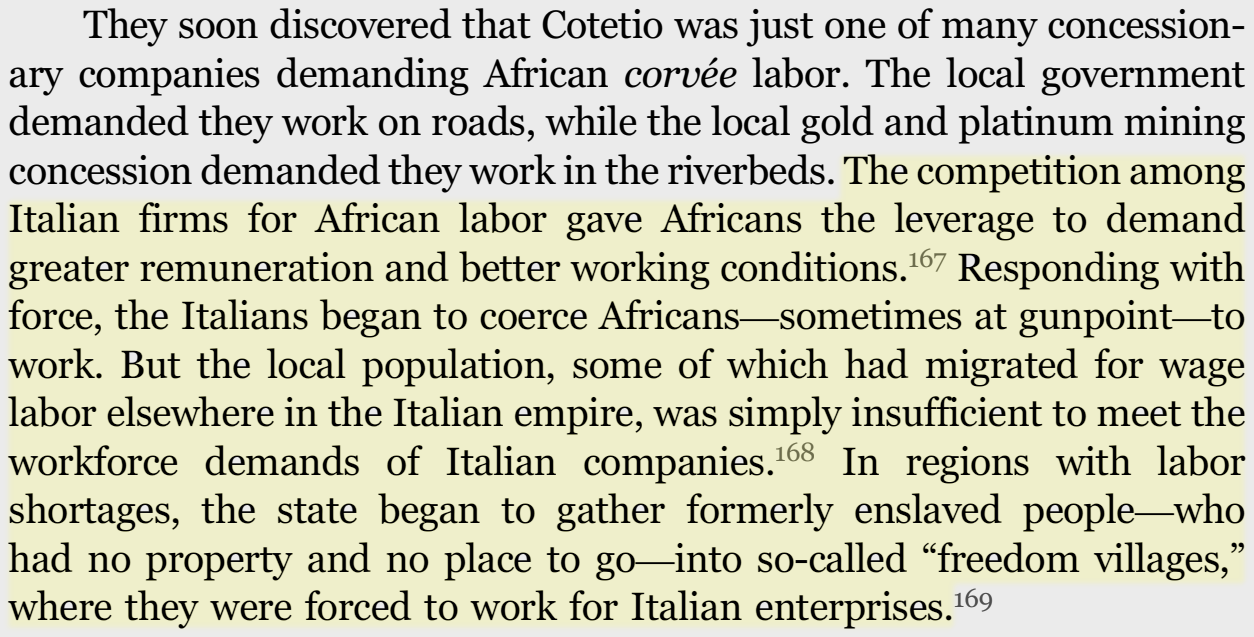
The fascists’ arrival ended Washington’s fears of another Bolshevik-style takeover, such as had occurred in Russia five years before in October 1917. A top level inquiry, conducted by U.S. president Woodrow Wilson’s administration in December 1917, warned of Italy that it poses “the obvious danger of social revolution and disorganisation”, as labour power intensified. A U.S. State Department official observed privately, “If we are not careful we will have a second Russia on our hands”, adding that “The Italians are like children” and should be “assisted more than almost any other nation”.
Mussolini’s street brawlers quickly solved the problem. The U.S. Embassy in Rome reported that the fascists are “perhaps the most potent factor in the suppression of Bolshevism in Italy”, expressing mild concern regarding the “enthusiastic and violent young men” comprising the Blackshirts. The U.S. Embassy elaborated further on the appeal of fascism to “all patriotic Italians”, simple people who “hunger for strong leadership”. (3)
U.S. corporations flocked to invest in Mussolini’s Italy. The American historian and analyst Noam Chomsky wrote, “As fascist darkness settled over Italy, financial support from the U.S. government and business climbed rapidly. Italy was offered by far the best postwar debt settlement of any country, and U.S. investment there grew far faster than in any other country, as the fascist regime established itself, eliminating labor unrest and other democratic disorders”. (4)
The irresistible attraction of big business towards fascist rule, like moths to a flame, tells its own story. With Mussolini one year in power, the U.S. Embassy eulogised in late 1923, “The results have been excellent, and during the last 12 months there has not been a single strike in the whole of Italy” (5). The Embassy believed that Mussolini was becoming a success because of his destruction of labour power, and therefore the erosion of a key democratic process.
Click here for events that happened today (November 23).
1897: Karl Franz Gebhardt, Axis war criminal, made the mistake of existing.
1934: While the Dornier Do 17 twin‐engine light bomber took flight for the first time and Fascist Arthur Greiser became the President of the Senate of Danzig, an Anglo‐Ethiopian boundary commission in the Ogaden discovered a Fascist garrison at Walwal, well within Ethiopian territory, leading to the Abyssinia Crisis.
1939: Fascist battleships Scharnhorst and Gneisenau sunk HMS Rawalpindi.
1941: The High Command in Rome agreed to put the Fascist XX Mobile Corps, which included the Ariete Division and the Trieste Division, under Erwin Rommel’s direct command, and Axis troops outflanked British forces south of Sidi Rezegh during the Battle of Totensonntag, inflicting heavy casualties and forcing the British 7th Armored Division to withdraw 20 miles. On the Eastern Front, the Luftwaffe II./KG 55 departed Kirovograd, Ukraine for Saint‐André‐de‐l'Eure, France for rest and refitting, and Axis forces captured Solnechnogorsk, Russia.
As destroyer Yuzuki departed Sakaide and I‐68 departed Kwajalein, Marshall Islands for her first war patrol in the Hawaii Islands area, Axis carriers made a rendezvous at Hitokappu Bay in preparation for the Pearl Harbor attack. The Reich’s ambassador in the Empire of Japan, Eugen Ott, also warned Berlin that the Imperial Japanese military seemed to be on the verge of a war, its military preparing to move southward, but he was unaware of Tōkyō’s plans to attack Hawaiʻi.
1942: Axis submarine facilities (at Saint Nazaire) and the Tianhe Airfield all suffered significant damage from Allied bombing, and the Axis lost the vital French West African port of Dakar simultaneously as Axis forces evacuated Agedabia, Libya, but the Axis submarines U‐625 and U‐601 successfully sank British freighter Goolistan and Soviet merchant ship Kuznets Lesov, respectively, massacring all eighty‐two people aboard both ships.
1943: Berlin suffered another assault from Allied aircraft, losing the Deutsche Opernhaus on Bismarckstraße in the process, and the Axis also lost Tarawa and Makin atolls to the Allies, but while the second Ta 152B prototype aircraft took flight in the Third Reich and three Axis ships arrived at the Caroline Islands, the Axis submarine U‐516 hit the unescorted American steam tanker Elizabeth Kellogg with a torpedo in the Caribbean Sea, resulting in ten deaths.
1944: Destroyer Yuzuki departed Kure, Japan, escorting carrier Junyo, and as U.S. soldiers in Belgium climbed out of their foxholes to line up for dinner, Axis artillery fire hit them and they suffered heavy casualties. In Finland, Fanni Luukkonen stepped down from her position as the chairman of Lotta Svärd as the Soviet Union forcibly disbanded the organization.
When, after four decades of dictatorship, Franco died in his sleep on November 20, 1975, Spain undertook what had until then been a rarity in its history: a peaceful transition from authoritarian dictatorship to liberal[ism]. Franco’s death was not accompanied by a complete collapse of the state. Instead, this transition would be conducted according to the legal codes and through the political institutions of the dictator’s own régime (Encarnación 2014). Major political and economic reforms were undertaken through negotiations between Franco’s successors and the recently legalized Socialist and Communist Parties.
In a country where people still bitterly disputed whether the Civil War represented the tragic defeat of a utopian-democratic project or a modernizing national crusade against an insurgent communist threat, political élites succeeded in making the case that the past was a subject best avoided (Aguilar Fernández 2002, 34).
Following then-contemporary ideas of best practices for [pseudo]democratic transition, Spain undertook a Pact of Oblivion, a tacit agreement among the political élite not to legislate, litigate, or discuss their recent history in the public sphere (Aguilar Fernández 2002; Encarnación 2014). The agreement would find its legal form in the 1977 Amnesty Law, preventing prosecutions of past crimes, including the over 130,000 forced disappearances committed by the dictatorship. By setting aside a still-divisive past, Spain’s political class hoped that, together, they might build a common future.
Initially, Spain’s transition to [pseudo]democracy garnered the country widespread international praise. As living standards rose concurrently with the consolidation of [pseudo]democratic institutions throughout the 1980s and 1990s, scholars began talking of an archetypical “Spanish model” for other postdictatorship countries to follow (Gunther 1992; Linz and Stepan 1996).
But throughout the Global South, there was emerging a new model of transitional justice. This model was based not on élite pact making and amnesty but on public remembering of and accountability for past crimes. As truth commissions, war crimes tribunals, and forensic exhumations captured international attention, the Spanish model, with its emphasis on impunity for and public amnesia of past crimes, appeared increasingly anachronistic.
[…]
In large part, the memory movement’s critique of sociological Francoism reflects the lack of political reforms during the transition. Spain’s was a pacted transition, one that sought to avoid a radical break with its dictatorial past. While the 1978 Constitution saw the formal end of the dictatorship and the inauguration of an elected parliament, the judiciary, and state bureaucracies, many parastatal institutions, including the Royal Academy of History, remain largely unchanged (Encarnación 2014).
At the same time, the movement’s critique also unearths the persistent traces of the Franco régime in the built environment. The Franco dictatorship lives on not only through the structure of certain political institutions but also, and even more so, in a network of material objects, embedded in both the urban and rural landscapes. Like other kinds of infrastructural nodes, these can be subtle, even invisible to the untrained eye (Star 1999).
At an exhumation in a small Castilian village, an activist took note of streets named General Mola and José Antonio, which paid homage, respectively, to General Emilio Mola, an early leader of Franco’s military coup, and José Antonio Primo de Rivera, founder of the fascist Falange Party. “How are these villages going to change?” he sighed. Here, streets signs do not just reflect a dictatorship long gone. They form part of a distributed network through which the Franco dictatorship continues to shape the Spanish present.⁶
[…]
In 2013 this village’s situation would repeat on a national scale when […] the then ruling party found itself in a public relations predicament over the fate of the Valley of the Fallen, the mausoleum where Franco is buried, together with 70,000 war dead who were exhumed and reinterred there. […] For relatives of the disappeared, […] many of whom were not even informed of, let alone given a chance to consent to, the transfer of their loved ones’ remains, the monument represented a further indignity (Ferrándiz 2011).
For them, the forcible transfer of republican bodies represented less an overture to heal a fractured nation than a violent attempt to tame the legacy of leftist resistance to fascism by forcibly entombing their kin in a monument designed to glorify the régime that they had died fighting. The stone monument thus functioned to contain both the bodies of Franco’s victims and the ideas they died for.
After Franco died, politicians largely left the site unchanged in accordance with their Pact of Oblivion. By 2013, however, the 150-meter-tall stone cross that Franco designed to “defy time and oblivion” was in such a state of disrepair that it endangered visitors.⁷
Like the chemical infrastructures analyzed by Michelle Murphy (2013) or the deteriorating late-industrial infrastructures analyzed by Kim Fortun (2014), the crumbling of the dictatorship’s most prominent symbol exemplified the capacity of Franco’s material remnants to forcibly insert themselves into the politics of the present. In the end, over the bitter complaints of the memory movement, the right-wing government budgeted nearly 287,000 euros to restore the infamous monument (Sastre 2013).
(Emphasis added.)
You may be surprised that, in terms of staff, the parliamentary monarchy inherited only a small percentage of politicians and bureaucrats from the parafascist era, but for some readers the results are going to look worrisome anyway.
Quoting Juan J. Linz’s, Miguel Jerez’s, and Susana Corzo’s Ministers and Regimes in Spain: From First to Second Restoration, 1874-2001, page 29:
Continuities with the pre[liberal] period have persisted within the local authorities, but in different proportions according to region; for example, 32.7 percent of Galician mayors during the latter years of Franco’s régime, while only 14.7 percent of Andalucian mayors — obtained either in 1973 by appointment of the civil governor and the Minister of Interior, or following the partial elections of January 1976 through a complex proceeding that was under the control of the Movimiento after the first [pseudo]democratic municipal elections of April 1979.
Data for both regions show a declining tendency in these figures during the 1980s, but again at clearly different rates: 20.8 and 17.3 percent, in 1983 and 1989, respectively, in Galicia where both conservative and clientelist tendencies were stronger (an overwhelming majority of the Francoist mayors continuing during the [pseudo]democracy were candidates in the lists of the state-wide national parties of the right or center, in those of the moderate nationalists, or in those of independent electoral coalitions, rarely on the left); and 5.6 and 2.6 percent for Andalucia where the left got much better results (Márquez 1992, 1993).
In terms of personnel, there is also a high degree of discontinuity between the memberships of Franco’s parliaments and those of the Parliamentary Monarchy. Only 12.9 percent of parliamentarians elected in June 1977 had also been procuradores under Franco, although this does not take into account the forty-one ‘royal’ senators — a designation that does not exist under the new constitution — sixteen of whom had been procuradores.
The presence of former members of the Corporatist Chamber, not all of whom were necessarily Franco supporters,²⁹ declined substantially in the first [pseudo]democratic parliament (to 8.6 percent), before disappearing as a consequence of the collapse of the UCD and the right’s poor electoral performance up to 1993 (the proportion of former procuradores amongst the centrist parliamentary deputies was only four percent above the average, among the small parliamentary representation of Alianza Popular their number was about one-half of the group, while there was none amongst the socialist deputies).³⁰
One should not overrate the significance of these small percentages, however, because even if only a few staff members transferred, many of the structures and rulebooks remain intact. As Jonah S. Rubin said, ‘the judiciary, and state bureaucracies, many parastatal institutions, including the Royal Academy of History, remain largely unchanged.’
Further reading: Democracy Without Justice in Spain: The Politics of Forgetting
Click here for other other events that happened today (November 20).
1851: Margherita of Savoy, monarchist and profascist, existed.
1867: Gustav Giemsa, Fascist chemist, started his life.
1875: Friedrich‐Werner Graf von der Schulenburg, Axis diplomat, came along.
1894: Johann Nikuradse, Axis professor, was created.
1902: Philipp Johann Adolf Schmitt, SS officer, disgraced life with his presence.
1914: Emilio Pucci, Fascist aristocrat, made life less pleasant.
1927: Wolfgang Schreyer, (brief) member of the NSDAP, arrived on this dust ball.
1936: José Antonio Primo de Rivera, founder of the Falange, died at the hands of the Republicans.
1939: Fascist submarine U-33 sank three small British trawlers (Thomas Hankins at 1030 hours, Delphine at 1600 hours, and Sea Sweeper at 1700 hours) off Tory Island, Ireland.
1940: Hungarian Prime Minister Teleki and Foreign Minister Csaky signed a protocol in Vienna, Austria, joining the Tripartite Pact, then 116 Axis bombers dropped 132 tons of high explosive bombs and 296 incendiary bombs on Birmingham overnight. On the other hand, Arturo Bocchini, head of the Fascist State Police and the OVRA, had the decency to drop dead, and Axis torpedo boat Confienza sank after colliding with Axis armed merchant cruiser Capitano A. Cecchi off Brindisi… no comment.
1941: The two crematoria of Auschwitz became inactive for servicing; camp commandant ordered that corpses of prisoners were to be transported to Birkenau (not yet a camp) for burying in mass graves until the servicing was done on December 3, 1941. As well, the Axis captured Rostov, and some anticommunists exeucted three prisoners of war in Vilnius.
The Axis upgraded the Ryojun Military Port (previously known as Port Arthur; now Lushunkou, Liaoning Province, China) along with the naval base at Mako in Pescadores Islands to the status of Guard Districts, and Eastern Axis ambassador to Washington, Nomura, presented the Empire of Japan's final proposal to keep peace in Asia and the Pacific.
1942: Adolf Schicklgruber relinquished personal command of Armeegruppe A to General Ewald von Kleist, and six He 111 bombers of Luftwaffe group KG 55 flew an armed reconnaissance mission from their base at Morozovskaya over Stalingrad; two flightcraft failed to return. Likewise, the Axis deployed paratroop Engineer Battalion “Witzig” along with the Italian 1st Paratroop Battalion together at Djebel Abjod, and the 3rd Battalion of the “San Marco” naval infantry regiment of the Regia Marina began arriving in Tunisia from Corsica.
1943: The Axis sent orders to deport northern Italy's Jews to concentration camps, and the Axis took nearly five thousand Allied prisoners on Samos Island, Greece. Berlin refused permission for the Armeegruppe Nord to withdraw to the Panther-Wotan Line while Kumano and her task force departed Truk in response to the Allied landings on Tarawa.
1944: The Third Reich's head of state left the Wolfsschanze Headquarters for Berlin for the last time in his life, and Oberleutnant zur See Otto Hübschen stepped down as the commanding officer of U-2501. Admiral Scheer, Prinz Eugen, Z35, Z36, and Z43 began shelling Soviet positions during the evacuation of the Sõrve (German: Sworbe) peninsula on the Estonian island of Saaremaa (German: Ösel). Similarly, Axis submarines I-36 and I-47 each delivered five Kaiten submarines off Ulithi, Caroline Islands. (Only one of the Kaiten submarines would find a target, setting the fleet oiler Mississinewa, full of aviation fuel, aflame.)
1945: The trials against twenty‐four Axis war criminals started at the Palace of Justice at Nuremberg.
1999: Amintore Fanfani, Fascist intellectual who wrote for La difesa della razza, was finally gone.
2013: Dieter Hildebrandt, Axis pilot, expired.
Similarly to Jewish men attracted to other men, mentally ill Jews (as well as people who were legally ‘Jewish’) suffered a unique discrimination that was in many ways intenser than what us mentally ill gentiles experienced:
Discrimination against Jewish mentally-ill was extended by virtue of government decree in June 1938, which required separation of Jewish from non-Jewish patients in state hospitals due to fears of “race defilement.” An order issued on 22 June, 1938 by the interior minister of the Reich declared: “Special attention must be paid to the danger of race desecration while accommodating Jews in hospitals. They must be physically separated from patients of German or allied blood… their freedom of movement…must exclude the danger of race desecration” (11).
It was stipulated that the law was to be particularly enforced in state hospitals. This led to extreme overcrowding in the few institutions that were still admitting Jewish mentally-ill. On 15 May, 1939, Jewish inpatients were made more distinct as Jews and required to insert a Jewish first name (Sara or Israel) to their German first name. This heralded a more ominous and deadly practice, a request for hospital administrators and physicians to compile a list of all Jewish patients in institutions, separated into males and females. This was already the beginning of the end.
[…]
The final stage of the discrimination against the Jewish mentally-ill was the ultimate undermining of their freedom and status — the euthanasia stage during which Jewish mentally-ill were targeted and systematically exterminated under the guise of participation in the T4 euthanasia program of “mercy killing.”
While not precise, the Reich Association of Jews in Germany (Reichsvereinigung) believed that there were approximately 2,500 Jews in German mental institutions in early 1940 (3). This estimation did not include Austrian and Polish Jewish mentally-ill nor Jewish mentally-ill patients from mixed marriages (3). The overall estimated figure would add up to approximately 5,000 Jewish victims of euthanasia killings.
[…]
Following the [Fascist] invasion of Poland, euthanasia of mentally-ill rapidly began in earnest. The first euthanasia action transpired as early as 22 September, 1939, with the murder of patients, five employees and the deputy director of the Kocborowo psychiatric hospital in the Gdańsk region (17). While the Polish mentally-ill subpopulation suffered to a great extent alongside their fellow Jewish patients, several factors indicated that the Jewish mentally-ill were singled out and underwent “special treatment” in several instances and were often the first to die.
Thus, Klee states that “beginning December 1939 the first Jewish patients have been taken from the provincial psychiatric institution Meseritz by the SS and ‘evacuated’ ‘to the East’” (6). Eyewitness accounts at the time reported that Jewish patients were boarded into busses and trucks and murdered by exhaust fumes piped into the vehicles or by shooting (18)
[…]
The T4 machine in Berlin began informing Jewish patients’ families or their principal caregivers (welfare societies, Jewish organizations, insurance agencies) that their relative had been transferred to Chełm hospital in the Lublin area of Poland. However, no patients transferred by T4’s Gekrat ever arrived in Chełm hospital and this institution served as subterfuge for T4 to extract money from those financially supporting these patients (6).
The Reichsvereinigung der Juden (Reich Association of Jews in Germany) contributed 350,000 marks and the Hamburg community 40,000 marks for medical treatment — immense amounts at the time (4, 7). T4 obtained information from the hospitals as to who was supporting patients. They then contacted them requesting payment for their accommodation and care while falsely declaring that they were representing the institutions where the patients had been transferred.
While this process appeared primitive, the deception succeeded for several months long after the patients were killed in [Fascist] euthanasia killing centers. […] T4 continued to receive payment for patient expenses from the time of patient transfer until dispatch of these death letters. The Chełm deception was created to fund T4 operations. […] In 1942, the sidewalks around the hospital were paved with tombstones from Chełm’s Jewish cemetery.
[…]
While much of the killing of the Jewish mentally-ill took place within context of the larger euthanasia program which did not target only Jews but in which many non-Jews died as well, evidence does exist that many non-mentally-ill Jews were also killed under the guise of T4 program, without consideration to the state of their health or the lack of illness.
Following spring 1941, this included a process whereby the “euthanasia” program extended to concentration camps under the name “Special Treatment 14f13.” Here, on the orders of Heinrich Himmler, T4 experts were sent to concentration camps to select prisoners incapable of work, who were then murdered in the “euthanasia” institutions (Hartheim, Bernburg, Sonnenstein).
Experts of the 14f13 Program based their decisions on political and racial, rather than “medical” criteria. Mainly Jewish inmates were included and died, without consideration to the state of their health (7)
(Emphasis added.)
I know that I delve into similar topics frequently, but I still flinched when I read some of this.
Being mentally ill myself, I can see how we would be easy targets during an extermination campaign. I struggle with depression, so if I were in Gaza right now I do not know if I would have the willpower to escape any dangers coming my way. That may be easy for somebody who is clinically paranoid or suffering from an anxiety disorder, but it can be very difficult for somebody who finds simple tasks like getting out of bed overwhelming. That is often what depression feels like. I can barely imagine what it must feel like for people who easily trust strangers, hear voices telling them to go somewhere unsafe, or have severe learning impairments.
And given how society generally sees us—as annoyances, burdens, serial killers, or consistently untrustworthy—help can be uneasy to find. This is why the Third Reich tested many of its lethal methods on us first, especially if we were Jewish: few would have noticed that we had gone missing, few would have missed us, and many of us were unproductive members of society, hence why the Fascists called ‘useless eaters’. In their eyes, we were all take and no give. There were similar incentives for testing Zyklon‐B on Soviet POWs first: anticommunists don’t usually care what happens to us communists.
In any case, my hopes in sharing this are to help Jewish people understand how the Shoah befell them. From mediaeval Judaists to Native Americans to Namibians to Armenians to communists to the mentally ill, quite a few of us were on the chopping block before our oppressors turned to focus on you (again). I would certainly never ‘take pride’ in something like that—it is no accomplishment!—but it remains a very useful reminder why the motto is and should be ‘Never again… for anyone.’
Click here for events that happened today (November 19).
1877: Giuseppe Volpi, Fascist Italy’s Minister of Finance, polluted the environment.
1906: Franz Schädle, Obersturmbannführer, was unfortunately born.
1907: Hans Liska, Axis propagandist, started his life.
1926: Giuseppe Umberto ‘Pino’ Rauti, Fascist politician, existed.
1940: Three hundred fifty‐seven Axis aircraft bombed Birmingham overnight, dropping 403 tons of high explosive bombs and 810 incendiary bombs, which resulted in about 900 dead and 2,000 injured, but Greek troops drove Axis ones across the Kalamas River in northwestern Greece.
1941: Franz Halder noted in his diary that, in a meeting that Adolf Schicklgruber held with his top military leaders on this date, Schicklgruber no longer talked about ending the war in 1941; instead, Berlin made plans for Soviet targets east of Moscow for spring and summer of 1942. Meanwhile, west of Moscow, the German 4th Panzer Army attempted to penetrate the gap between the Soviet 30th and 16th Armies which were pushed back on the previous day, but defiant Soviet resistance slowed the Axis advance in the area of Istra.
In Oceania, Axis raider HSK Kormoran intercepted HMAS Sydney west of Shark Bay, with HSK Kormoran firing the first shot at 1730 hours and leaving both ships heavily damaged after the 20‐minute battle. In Africa, the Axis Ariete Division halted the advance of British 22nd Armoured Brigade at Bir el Gubi, Libya, and destroyed or disabled forty British Crusader tanks, but elsewhere the Axis lost the Sidi Rezegh airfield around the same time that the tanks of the British 4th Armoured Brigade engaged Axis tanks of the 21st Panzer Division.
1942: The Axis started losing the Battle of Stalingrad as a surprise counterattack encircled Friedrich Paulus’s German 6th Army, but Axis forces under General Walter Nehring assaulted and penetrated the Vichy defense line at Majaz al Bab, Tunisia. A raid on the Axis‐controlled Vemork heavy water plant at Telemark, Norway, came to grief when the gliders carrying thirty‐four commandos crashed, and the Axis shot all of the survivors after torturous interrogations.
1943: En route to a gas chamber at Auschwitz II, Bina Braun and Rosa Theberger attempted to escape, but the Axis caught them, shot both, and annihilated the rest. Somebody stole the list of 394 prisoners massacred on this day and smuggled it to the resistance leader in Auschwitz I, who then sent the list on to Krakow on November 21 and then to London.
1944: The Waffen‐SS assaulted thirty members of the Luxembourgish resistance in the town of Vianden.
It is obvious that we, from every aspect, have a better “pretext” for many of our actions. Yet there is also a monster in each of us, and if we continue to assume that we are always justified, that monster can grow. Therefore, we Jews are obliged to always hold the German example before our eyes. Already today I am addressing a phenomenon which is growing: there is an entire sector in the Jewish public which I unhesitatingly define as a copy of the German Nazis.
Look at the children of the Jewish Hebron settlers: they are exactly like the Hitler Youth. From infancy they are pumped with ideas that all Arabs are bad, of how every Gentile is against us. They are turned into paranoids, they think themselves as a master race, they are exactly like the Hitler Youth. There is a very dangerous tendency of lenience towards that sector. MK Rehavam Zeʻevi was brought into the government coalition,³ and people still think that the Kahane movement can be dealt with by the usual means. I am reminded of those conservatives in Germany who collaborated with Hitler out of exactly the same reasons and who made the same mistakes as we now do.
Because of this polemic, somebody (unsuccessfully) tried to sue Prof. Zimmerman for libel.
Click here for events that happened today (November 18).
1936: Berlin and Rome officially recognized General Franco's government in Spain. On the same day, Benito Mussolini authorized a Fascist expeditionary corps to be sent to Spain.
1938: Spanish Nationalist forces pushed Spanish Republican forces back across the River Ebro in Spain.
1939: At Salzburg, Austria, Adolf Schicklgruber told the Fascist Foreign Minister Count Galeazzo Ciano that Benito Mussolini's invasion of Albania was to blame for the Royal Air Force being allowed to establish bombers in Greece within reach of the Third Reich's main fuel supply, the oil fields of Ploiești, Romania. In reality, Ioannis Metaxas's government refused to allow the British to threaten the Romanian oilfields in order to avoid provoking the Reich.
1940: Chancellor Adolf Schicklgruber and Fascist Foreign Minister Galeazzo Ciano met to discuss Rome’s disastrous invasion of Greece. Axis submarine U-65 sank Allied tanker Congonian one hundred twenty-five miles west of Freetown, Sierra Leone at 1802 hours, killing somebody.
Maggiore Baracca set course for Bordeaux, France in the northern Atlantic Ocean at 1130 hours. At about 1735 hours, she spotted smoke, but an accidental fire in the starboard diesel engine caused her to slow her approach. Nevertheless, she caught up with freighter Lilian Moller of Allied convoy SLS 53D, carrying pig iron from Calcutta in India for the United Kingdom, at 2147 hours. She fired a torpedo from a bow tube, which missed. At 2303 hours, she fired another torpedo from a bow tube, hitting the freighter in the stern. Lilian Moller sank at 2347 hours. Somebody spotted one lifeboat with survivors, but it would never be seen again, thus all 49 aboard the freighter were lost as the result of the sinking. (Forty-two of those lost were Chinese sailors.)
1941: Tōkyō requested Berlin to not conclude a separate peace with any common enemies of the two empires, but did not share its plans to attack Imperial America either. Five large Axis carrier submarines, each containing midget submarines, departed from the Kure Naval Base for Pearl Harbor. (Joseph Rochefort's U.S. Navy cryptanalytic team reported no Imperial carrier movement.)
The 4th Panzer Army launched a 400-tank attack 70 miles west of Moscow, supported by 3 infantry divisions; Soviet 30th Army fell back northward to Klin, while Soviet 16th Army was pushed south to Istra. One hundred twenty miles south of Moscow, the 3rd Panzer Army became held up at Tula, with its latest attempt to surround the Soviet garrison there foiled by the newly-arrived Soviet 413th Rifle Division. Lastly, the Regia Marina, which had not heard from Alessandro Malaspina for two months, officially listed him as lost at sea, with the reason being unknown.
1942: About one thousand Jews from ghettos of Grodno, Byelorussia arrived at Auschwitz; the Axis registered 165 men and 65 women, but annihilated the remaining 770. Additionally, Marshal Philippe Pétain signed a constitutional document permitting Prime Minister Pierre Laval to make laws and issue decrees on his own signature only.
1943: The Axis captured Zhytomyr, Ukraine as Berlin suffered an Allied bombing that resulted in 131 deaths, but was otherwise light in damage, and the RAF lost nine flightcraft in addition to fifty‐three people.
1944: Adolf Eichmann ordered the deportation of 18,000 Jews from Budapest to concentration camps.
1945: António de Oliveira Salazar retained his seat as the Prime Minister of Portugal in a re-election, but twenty-one Axis leaders faced indictment at the first open session of the International Military War Crimes Tribunal.
1977: Kurt Schuschnigg, Austrofascist Chancellor, dropped dead.
[Transcript]
Mogen Dovid and Swastika To Fly Side by Side
HAMBURG — The Blue and White Zionist flag with the Mogen Dovid, the star of David, will fly side by side with the [Fascist] swastika flag, when two [Fascist] boats will begin to operate, within a short time, on Palestinian coastal transport.
The Atlantic Shipping Company is sending two motorships to Palestine loaded with the belongings of German Jews who have emigrated to Palestine. As the ships are registered in [the Third Reich] they are bound to carry the official [Fascist] flags. But upon their arrival in Palestine, where they will be used for local service, they will in addition fly the Zionist flag, probably in the hope of securing Jewish business and of counteracting the hatred of the swastika flag.
Source: The Jewish Western Bulletin, November 9, 1933. Credits to Tony Greenstein’s Zionism During the Holocaust: The Weaponisation of Memory in the Service of State and Nation, page 86, for showing me this.
Click here for events that happened today (November 17).
1901: Walter Hallstein, Axis Oberleutnant, existed.
1906: Soichiro Honda, Axis industrialist, started his life.
1931: Imperial troops assaulted Qiqihar, Nenjiang Province, and Imperial artillery bombardment along with cavalry charges overwhelmed Chinese defensive lines.
1932: Franz von Papen resigned as the Weimar Republic’s Chancellor.
1933: For the first time the Third Reich sent people to its concentration camps for reasons unrelated to their politics.
1939: The Third Reich executed nine Czech students as a response to antifascist demonstrations prompted by the death of Jan Opletal. The Fascists shut down all Czech universities and sent more than 1,200 students to concentration camps.
1940: Hamburg suffered another Allied bombing for the twoth night in a row.
1941: Following twelve months of illness, depression and strain at the Luftwaffe’s increasing losses on the Eastern Front, Generaloberst Ernst Udet, the Third Reich’s Director General of Air Armament, suicided by shooting himself while on the telephone with his girlfriend, Inge Bleyle. Udet, the German Reich’s second highest fighter ace of the First World War (behind the Red Baron) with 62 kills, had already lost favour with his Chancellor after the air force’s performance in the Battle of Britain. The official version was that he had died whilst testing a “new weapon” and Jagdgeschwader 3 was named in his honour. Udet was accorded a state funeral at which he was eulogised by Hermann Göring, who described him as his “best friend”.
Additionally, Axis troops near Moscow fought Central Asian troops for the first time (Soviet 44th Cavalry Division) at Musino, 70 miles west of the capital. Axis artillery blunted the cavalry charges, with the Axis claiming 2,000 killed. Likewise, Luftwaffe III./KG 55 received orders to relocate from Kirovograd, Ukraine to Saint-André-de-l’Eure, France for rest and refitting after spending only seven weeks at Kirovograd. Around the time, the Reichskommissariat Ostland became established under Alfred Rosenberg to administer territories stolen from the Soviet Union.
Lastly, Axis Admiral Yamamoto revealed the Pearl Harbor attack plan to the IJN’s leadership, then Axis special envoy Kurusu Saburo arrived in Washington, D.C. and met with U.S. Secretary of State Cordell Hull.
1942: The Axis formally absorbed the French Protectorate of Tunisia into the borders of Italian North Africa, and the 3rd Battalion of the Eastern Axis’s 229th Infantry Regiment along with 300 reinforcements landed near Gona.
1943: Foch’s wreck was captured by the Axis at Toulon, and London announced that Sir Oswald Mosley, well known British fascist, was to be released from imprisonment due to health reasons, provoking public protest. Axis submarine I-176 fired three Type 95 torpedoes at an unidentified submarine south of Truk in the Caroline Islands, claiming two hits. (The target was believed to be USS Corvina.) Lastly, Axis commander Koichi Shiozawa passed away from an acute pancreas ailment, and somebody relieved Shokaku’s commanding officer Captain Hiroshi Matsubara; the successor was unknown.
1944: Axis physicist Yoshio Nishina reported to his army liaison officer Major General Nobuji that the atomic bomb research project under him had not made much progress in the past nine months. This was partly because his cyclotron could not operate at full power due to the poor quality vacuum tubes. Apart from that, Vice Admiral Kinpei Teraoka became the commanding officer of the IJN’s 3rd Air Fleet.




